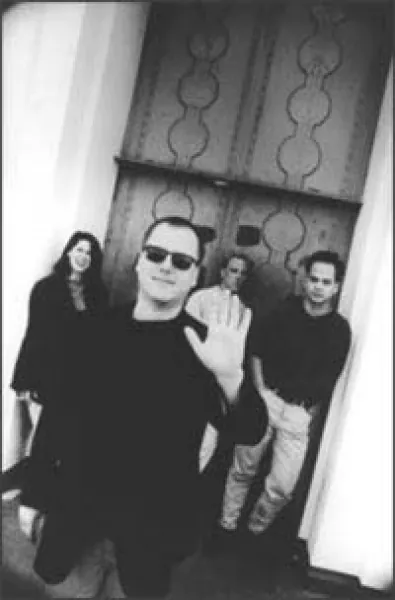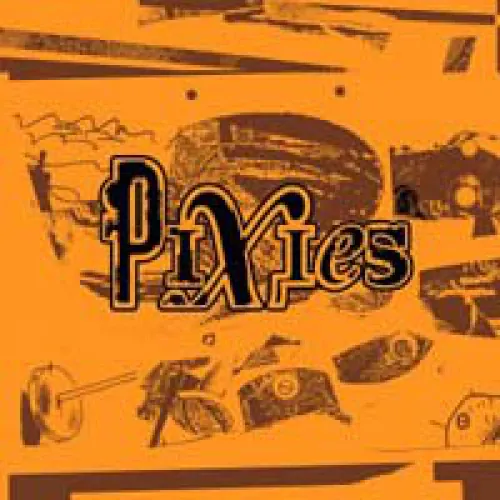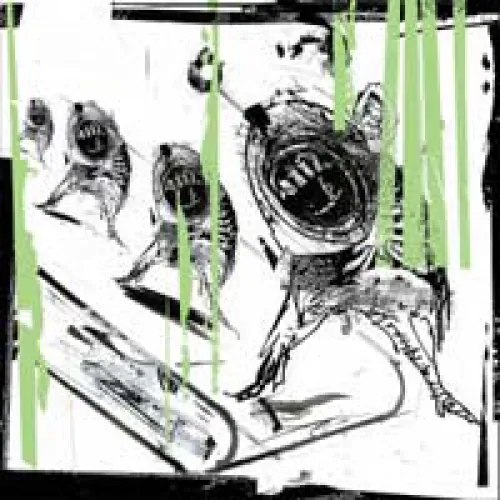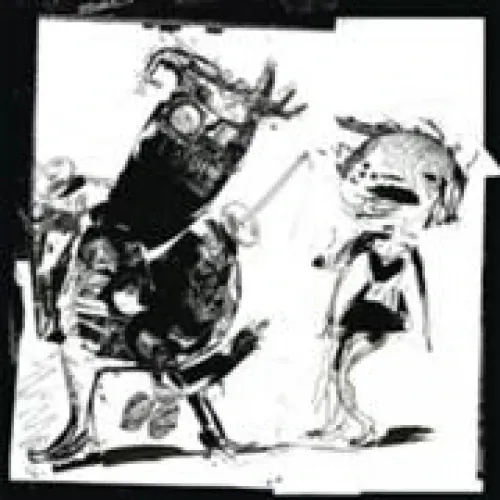
Pixies
Top Pixies albums
Top Pixies lyrics
Pixies biography
Combining jagged, roaring guitars and stop-start dynamics with melodic pop hooks, intertwining male-female harmonies and evocative, cryptic lyrics, the Pixies were one of the most influential American alternative rock bands of the late '80s. The Pixies weren't accomplished musicians -- Black Francis wailed and bashed out chords while Joey Santiago's lead guitar squealed out spirals of noise. But the band were inventive, rabid rock fans that turned conventions inside out, melding punk and indie guitar rock, cla**ic pop, surf rock, and stadium-sized riffs with singer/guitarist Black Francis' bizarre, fragmented lyrics about space, religion, s**, mutilation, and pop culture; while the meaning of his lyrics may have been impenetrable, the music was direct and forceful. The Pixies' busy, brief songs, extreme dynamics, and subversion of pop song structures proved one of the touchstones of '90s alternative rock. From grunge to Britpop, the Pixies' shadow loomed large -- it's hard to imagine Nirvana without the Pixies' signature stop-start dynamics and lurching, noisy guitar solos. While the Pixies were touted as the band to bring indie rock into the mainstream, they simply laid the groundwork for the alternative explosion of the early '90s. MTV was reluctant to play their videos, while even modern rock radio didn't put their singles into regular rotation. Furthermore, tensions between leader Black Francis and ba**ist/vocalist Kim Deal, who wanted to incorporate her songs into the band's repertoire, crippled the band's progress. By the time Nirvana broke the doors down for alternative rock in 1992, the Pixies were effectively broken up.br /br /The Pixies were formed in Boston, MA, in 1986 by Charles Thompson and his roommate, Joey Santiago. Born in California, Thompson began playing music as a teenager, before he moved to the East Coast during high school. Following graduation, he became an anthropology major at the University of Ma**achusetts. Half way through his studies at the college, he went to Puerto Rico to study Spanish, and after six months he decided to move back to the U.S. to form a band. Thompson dropped out of school and moved to Boston, managing to persuade Santiago to join him. Advertising in a music paper for a ba**ist who liked "Husker Du and Peter, Paul & Mary," the duo recruited Kim Deal (who was billed as Mrs. John Murphey on the group's first two records), who had previously played with her twin sister Kelly in the folk-rock garage band the Breeders in her hometown of Dayton, OH. On the advice of Deal, the group recruited drummer David Lovering. Inspired by Iggy Pop, Thompson picked the stage name Black Francis and the group named itself the Pixies after Santiago randomly flipped through the dictionary.br /br /By the fall, the Pixies had played enough gigs to land a supporting slot for fellow Boston band Throwing Muses. At the Muses concert, Gary Smith, an artist manager and producer at Boston's Fort Apache studios, heard the group and offered to record them. In March 1987, the Pixies recorded 18 songs over the course of three days. The demo, dubbed iThe Purple Tape/i, was given to key players within the Boston musical community and the international alternative scene, including Ivo Watts, the head of England's 4AD Records. Impressed with the ca**ette, Watts signed the band and released eight of the demo's songs as the EP Come On Pilgrim in 1987.br /br /The Pixies convened to record their first full-length album, Surfer Rosa, with producer Steve Albini, who had pioneered the thin, abrasive indie-guitar grind with Big Black. Albini gave the band a harder-edged, abrasive guitar sound, yet the group retained its melodic hooks. Released in the spring of 1988, Surfer Rosa earned enthusiastic reviews from the British weekly music press and became a college radio hit in America; in the U.K., the album made inroads on the pop charts. By the end of the year, the buzz on the Pixies had become substantial, and the group signed to Elektra Records. At the end of 1988, the group re-entered the studio, this time with British producer Gil Norton. Released in the spring of 1989, Doolittle boasted a cleaner sound and received excellent reviews, which led to greater exposure in America. "Monkey Gone to Heaven" and "Here Comes Your Man" became Top Ten modern rock hits, clearing the way for Doolittle to peak at number 98 on the U.S. charts; in the U.K., it entered the charts at number eight. Throughout their career, the Pixies were more popular in Britain and Europe than America, as evidenced by the success of the Sex and d**h tour. The band became notorious for Black Francis' motionless performances, which were offset by Deal's charmingly earthy sense of humor. The tour itself became infamous for the band's in-jokes, such as playing their entire set list in alphabetical order. By the completion of their second American tour for Doolittle at the end of 1989, the group had begun to tire of each other and decided to take a hiatus during the beginning of 1990.br /br /During the hiatus, Black Francis went on a brief solo tour and Kim Deal formed a group with Tanya Donnely from the Throwing Muses and ba**ist Josephine Wiggs of Perfect Disaster, naming it after her teenage band, the Breeders. The Breeders recorded the Albini-produced Pod, which appeared on 4AD in early summer 1990, shortly after the Pixies reconvened to record their third album with Gil Norton. More atmospheric than its predecessors, and relying heavily on Francis' surf rock obsession, Bossanova was released in the fall of 1990; unlike Surfer Rosa or Doolittle, it contained no songs by Deal. Bossanova was greeted with decidedly mixed reviews, but the record became a college hit, generating the modern rock hits "Velouria" and "Dig for Fire" in the U.S. In Europe, the record expanded the group's popularity, hitting number three on the U.K. album charts and paving the way for their headlining appearance at the Reading Festival. Though the supporting tours for Bossanova were successful, tension continued to grow between Kim Deal and Black Francis -- at the conclusion of their English tour, Deal announced from the stage of the Brixton Academy that the concert was "our last show."br /br /While the Pixies did cancel their planned American tour, due to "exhaustion," the band reconvened in the spring of 1991 to record its fourth album, again with Gil Norton. Hiring former Captain Beefheart and Pere Ubu keyboardist Eric Drew Feldman as an auxiliary member, the band moved back toward loud rock, claiming to be inspired by the presence of Ozzy Osbourne in a neighboring studio. Upon its fall release, Trompe le Monde was hailed by some as a welcome return to the sound of Surfer Rosa and Doolittle, but closer inspection revealed that it relied heavily on sonic detail and featured very few vocals by Deal and none of her songs. The band embarked on another international tour, playing stadiums in Europe but theaters in America. During the spring of 1992, the Pixies opened for U2 on the opening leg of the Zoo TV tour; it would be their last trek through the United States. Upon the conclusion of the Zoo TV tour the Pixies went on hiatus, with Deal returning to the Breeders, who releasing the EP Safari later that spring. Francis began working on a solo album.br /br /As he was preparing to release his solo debut, Francis gave an interview on BBC's Radio 5, announcing that the Pixies were disbanding. He hadn't yet informed the other members; later that day, he faxed them his statement. Inverting his stage name to Frank Black, Francis released his eponymous debut that spring to mixed reviews; over the next few years, Frank Black's audience gradually shrank to a small cult following. The Breeders released their second album, Last Splash, in the fall of 1993. The album became a surprise hit, going gold in the U.S. and spawning the hit single "Cannonball." Soon after, Deal also formed the Amps, who released their one (and only) album, Pacer, in 1995. Santiago and Lovering formed the Martinis in 1995 and appeared on the soundtrack to Empire Records. Although 4AD began issuing archival Pixies releases, including d**h to the Pixies 1987-1991, Pixies at the BBC, and Complete B-Sides in the late '90s and early 2000s, those were relatively quiet years for the band's members. After releasing the disappointing The Cult of Ray for American in 1996, Black shuffled between different labels before ending up at spinART for 1999's Pistolero, where he also released his subsequent solo albums, most of which were met with a fair-to-middling response. Deal and the rest of the Breeders, meanwhile, suffered from problems ranging from substance abuse to writer's block, and only surfaced intermittently, spending time in the studio but only having a cover of 3 Degrees' "Collage" on the soundtrack to 1999's The Mod Squad to show for their efforts until they released Title TK in 2002. David Lovering left the Martinis and became the touring drummer for Cracker, and also appeared on Tanya Donelly's Sliding and Diving, but found himself unemployed in the late '90s. Combining his studies in electronic engineering at Wentworth Institute of Technology and his years of performing experience, Lovering dubbed himself a "scientific phenomenalist," a cross between a scientist, performance artist, and magician, and warmed up the crowds at Frank Black, Breeders, Camper Van Beethoven, and Grant Lee Buffalo concerts. Santiago and his wife Linda Mallari continued the Martinis through the '90s, recording several demos and self-released albums. Santiago also began a career composing soundtracks and incidental music, beginning with the score for 2000's Crime & Punishment in Suburbia, to which Black also contributed a track. At the time, rumors circulated that Santiago would join Black on-stage during one of his London dates on the Dog in the Sand tour; though this didn't happen, it at least sparked hopes that the Pixies would eventually reunite. These hopes seemed unfounded until 2003, when Black revealed in an interview that he had considered reuniting the band and that he, Deal, Santiago, and Lovering occasionally got together to jam. Soon after, it was confirmed that the Pixies would reunite in 2004 for U.S. tours in the spring and fall; an appearance at that year's Coachella festival; and gigs in Europe and the U.K. that summer, including performances at the T in the Park, Roskilde, Pinkpop, and V festivals. All 15 of the band's North American warm-up tour dates were recorded and released in limited editions of 1,000 copies, which were sold online and at the shows. The week after the Pixies' Coachella appearance, the long-awaited DVD retrospective Pixies and revamped best-of Wave of Mutilation: The Best of Pixies were released by 4AD. ~ Stephen Thomas Erlewine, All Music Guide




